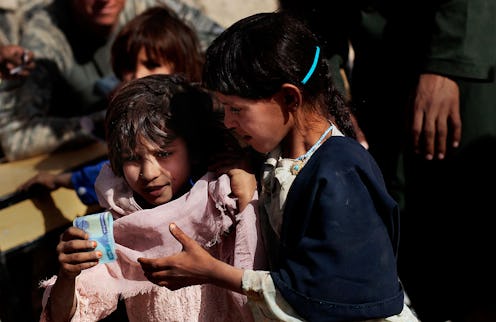News
Are Women At Risk of Economic Ruin?
Half a century ago, President Lyndon Johnson called for a War on Poverty, and over the next ten years, the poverty rate in the U.S. fell by 43 percent. Sadly, today, over a third of Americans are either living in, or on the brink of, economic distress. That's over 100 million people, and almost half of those are women. According to a report released Sunday, 42 million women and their children are living in poverty — and they're only a piece of bad luck away from complete financial ruin.
The Shriver report, co-written by Maria Shriver — daughter of Sargent Shriver, who spearheaded the War on Poverty — has some disheartening findings. With unemployment at over 7 percent, benefits recently being cut off for millions of Americans, and families in the top 1 percent having a net worth roughly 288 times higher than your average family (and Congress being one of the worst for that), times are hard all around. But in spite of today's Lean In culture, where women represent over half the country's voters and two-thirds of American families rely on the mother’s income, females are still the ones struggling the hardest on the economic margins.
According to the report, the average family isn't your nuclear package anymore: over half of children born to mothers aged 30 and under are born into single-parent households, meaning that over half of young mothers are single-handedly supporting both themselves and their children. The median amount of money a full-time woman employee will earn is still less than what her male counterpart will (making only 77 percent of the amount he would); and although women represent a high percentage of college graduates, the lack of benefits and wage increases has meant that they're much more likely to work pink-collar jobs that don't give them financial security. In fact, women make up almost two-thirds of the minimum wage workers across the U.S. — shockingly, the report says that over 70 percent of those workers get no paid sick days at all.
“These are people who are trying to survive on minimum wage, which is not a living wage,” Shriver said on NBC’s Meet the Press Sunday. “The number one thing that would make the most difference to them is getting sick days."
The researchers found that nearly a third of low-income mothers wished they had postponed having children, with a large number of women saying they regretted not prioritizing their education more. Over half of the low-income women polled regretted marrying early as well — whereas only 33 percent of the men said they regretted tying the knot when they did.
In an article she wrote for The Atlantic recently about the report, Shriver emphasizes how different the economic solutions of today have to be, compared with fifty years ago. She writes:
Our government programs, business practices, educational system, and media messages don’t take into account a fundamental truth: This nation cannot have sustained economic prosperity and well-being until women’s central role is recognized and women’s economic health is used as a measure to shape policy.In other words, leave out the women, and you don’t have a full and robust economy. Lead with the women, and you do. It’s that simple, and Americans know it.
But she also highlights the need for women to come together on this, across political and ideological divides:
But the truth is that for so long, America’s women have been divided: women who are mothers versus women who are not, women who work at home versus women who work outside the home, those who are married versus those who aren’t, pro-life women versus pro-choice, white women versus women of color, Democrat versus Republican, gay versus straight, and young versus old. It feels like the last issue where women came together was fighting for the right to vote.
Fifty years ago, the American Dream was essentially a male-oriented success myth — men were given the tools and opportunities to climb the economic ladder, while women struggled to be recognized. Magazines like Cosmo gave women access to the myth by providing them the tools by which to get the right man, one who would give them a house in the suburbs and all the financial security that implies. Thankfully, that's no longer the case today, but that mentality is still around: one of the key ways to change the economic hardship faced by women, Shriver says, is for women to think of themselves “as providers, not being provided for."
It’s time to come together again. By pushing back and putting into practice the solutions we’re proposing in The Shriver Report, we can re-ignite the American Dream—for ourselves, for our daughters and sons, for our mothers and fathers, for our nation. We have the power—not just to launch a new War on Poverty, but a new campaign for equity, for visibility, for fairness, for worth, for care.
Women are still fighting an economic battle, and not just in the U.S. They make up half of the world's total population while representing a jaw-dropping 70% of the world's poor. They produce half of the world's food and work two-thirds of the world's working hours, but they make less than 10 percent of the world's income. Less than one percent of the world's property is owned by women. Those are some sad numbers. But the report concludes with some optimistic advice to us, its readers: "Top of the list: Read the report, get smart, invest in yourself, use your economic power, engage men as allies, vote, be a 21st Century “boss,” finance women’s work, mentor and motivate girls, and be an architect of change."
Done, and done.
Image: Getty Images
